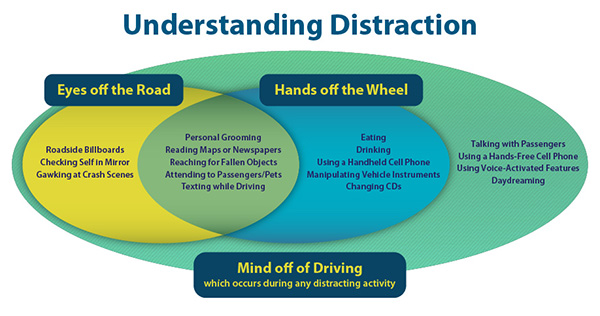Why is Distracted Driving a Problem?
Distractions take a motorist’s attention off driving, which can make a driver miss critical events, objects, and cues or abandon control of a vehicle, all potentially leading to a crash. Distracted drivers put not only themselves at risk, but everyone else using the road. According to NHTSA, one of every ten fatal crashes in the U.S. involves distraction, resulting in more than 3,000 deaths per year.
What Counts as Distracted Driving?
Countless distracting activities can divert driver attention and any one of them can increase the risk of a crash.
How Risky Is Distracted Driving?
Distracted driving is very risky and is known to lead to fatal car crashes. NHTSA estimated in 2012 that distraction was a factor about 10 percent of all fatal motor vehicle crashes and 18 percent of all crashes causing injury. The exact toll is unknown because Investigators often have difficulty measuring the extent to which driver distraction is a contributing factor in a crash. Wireless device records are usually only accessed in cases of death or serious injury, drivers may not admit fault and police may not always be able to discern the role of distraction. Methods of reporting are improving, but current estimates likely underestimate how frequently distraction causes crashes.
The AAA Foundation for Traffic Safety has sponsored research on distracted driving since the early 1990s.
- The Foundation’s analysis of data from a 2006 study conducted by Virginia Tech’s Transportation Institute revealed that taking your eyes off the road for more than two seconds doubles your risk of a crash.
- The Foundation’s annual Traffic Safety Culture Index, which measures national attitudes towards road safety, consistently finds that drivers are willing to engage in distracting behaviors behind the wheel despite knowing the dangers. According to the 2013 Traffic Safety Culture Index, 83 percent of motorists rated texting while driving and 58 percent rated cell phone use very serious threats to their safety, yet many admitted performing these distracting behaviors while driving within the previous month. Further, 88 percent of respondents said that distracted drivers were somewhat or a much bigger problem today than they were just three years ago.
- The pervasiveness of a ‘do as I say, not as I do’ attitude toward distracted driving highlights the need to spread awareness of the risks and work with drivers to increase safety on the roads.
- The Foundation is conducting groundbreaking research on the role of mental distraction in crashes, including the safety of voice-activated communications technologies.
View AAA’s compendium and fact sheet on distracted driving research to date.
Is Cell Phone Use While Driving Safe?
As one of the most visible sources of distracted driving, cell phone use has attracted much of the focus on distraction to date. A 2008 AAA Foundation report reviewed dozens of studies and concluded that any cell phone use roughly quadruples crash risk. With one out of every 20 drivers using a handheld cell phone at any given time, safety for all road users is a key concern.
Many believe that hands-free phones are safer than handheld phones. Numerous research studies, however, conclude that hands-free cell phones offer no significant safety benefits over handheld phones – hands-free is not risk-free. Some states and cities have laws that ban drivers from using handheld phones but allow hands-free use, which further confuses the issue.
Drivers should not use a cell phone – whether handheld or hands-free – while behind the wheel. Read the latest Foundation research on mental distraction and its role as a key risk factor when using a cell phone behind the wheel.
Many objects and activities both inside and outside the vehicle can pose visual, manual, and mental distractions:





